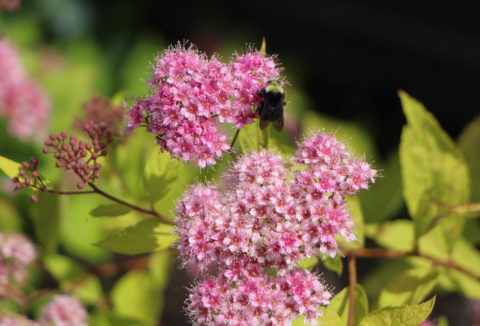
Adding a variety of flowering plants to your garden is one of the best ways to help pollinators. Annette Frahm photo.
This week, June 19-25, is National Pollinator Week. It is a time to celebrate the valuable services we get from bees, birds, butterflies, bats and beetles.
Ten years ago the U.S. Senate unanimously approved naming a week in June as “National Pollinator Week.” It was a way to bring attention to the severe decline in pollinators. Pollinator Week is now celebrated across the world.
Pollinators are important–and declining
About 75% of all flowering plants rely on animals to carry pollen from flower to flower. More than 200,000 species of animals act as pollinators, according to the Pollinator Partnership. About 1,000 are hummingbirds, bats and small mammals. Most pollinators are beneficial insects such as beetles, bees, ants, wasps, butterflies and moths.
Pollinators help about a third of world crop production. In the United States this is worth $20 billion annually. Foods and beverages produced with the help of pollinators include blueberries, chocolate, coffee, melons, peaches, pumpkins, vanilla and almonds.
We have seen a huge decline in pollinators over the last several years. For example, beekeepers in the US have lost about 30% of their colonies every year since 2006, according to the Bee Informed Partnership. Total annual losses sometimes reach as high as 42%. There are several reasons for the decline:
- Climate change
- Habitat loss from development
- Toxins, including pesticides, herbicides and fungicides
- Exotic pests and diseases, such as mites
- Loss of forage (food plants and flowers)
Bees are the most important pollinators
Solitary bees. Most (90%) of bees are solitary. A lone female makes a burrow and raises offspring alone. Males are present only to mate. Among these are the orchard mason bee, leaf cutter bee and west coast green berry bee.
Social bees live in colonies. These include the familiar honey bee and bumble bee. A colony has one queen bee and many worker bees. They are especially valuable as pollinators because they occur in large numbers and they visit many species of flowers.
How to help pollinators in your garden
Design your garden to have flowers blooming throughout the year. Some pollinators are active in spring and others later in the growing season. Having flowers in different seasons also adds color and fragrance to your garden.
Plant native plants, and look for those that provide both provide nectar for adults and food for insect larvae. Here are a few lists of plants that pollinators will appreciate.
Xerces Society: Pollinator Plants for the Maritime Northwest
Pollinator Partnership: Pacific Lowland Regional Guide
Great Plant Picks:
Select old-fashioned varieties of flowers whenever possible. Breeding has caused some modern blooms to lose their fragrance, which attracts pollinators. Some have also lost the nectar or pollen needed to feed pollinators.
Install houses for native bees, such as orchard mason bees and leafcutter bees, and for bats. We wrote a post earlier this year on mason bees. Here is information from the Xerces Society on building nests for native bees. The National Wildlife Federation has instructions for building a bat house.
Avoid pesticides. Even less-toxic pesticides can harm pollinators. If you must use them, use the most selective and least toxic ones and apply them at night when most pollinators aren’t active. Grow Smart, Grow Safe lists pesticides by brand name, so you can find out which ones are least toxic.
Supply a source of water. A dripping faucet or a suspended milk carton with a pinhole in the bottom will work for some insects. Other wildlife need a small container of water.
#PollinatorWeek
